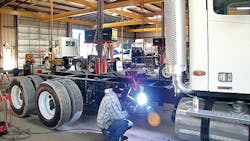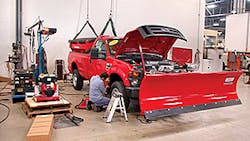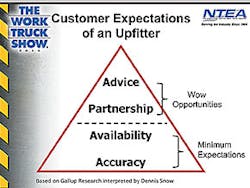Proper vehicle certification involves weight-distribution calculations, payload analysis and FMVSS compliance
PROPER vehicle certification is much more than a simple label on your truck.
Aside from being required by law, it helps ensure a safe, reliable, and capable vehicle. There are a number of factors involved in certifying a vehicle—including weight-distribution calculations, payload analysis, and Federal Motor Vehicle Safety Standard compliance—and they all matter. A properly certified vehicle is important to a company from a risk-management perspective.
In “Understanding Vehicle Certification: The End-User and Fleet Perspective of Risk Management,” NTEA managing director Mike Kastner and NTEA director of technical services Bob Raybuck said compliance involves 49 CFR Part 571-FMVSS, 61 FMVSS, and 49 FMVSS applicable to “Trucks.”
Final-stage manufacturers, intermediate manufacturers, and alterers of motor vehicles and motor vehicle equipment are required to certify.
Manufacturers, alterers, modifiers, dealers, leasing companies, fleets, and end users should know about vehicle certification.
“Everyone in the chain should both care about certification and have an understanding of the ‘how to’ basics as well as the ‘why it is important’ side of it,” Kastner said. “Regardless of where you stand in this chain, you should be able to explain to those on either side of you why it is important and why you should be doing business with companies that understand it. As required by law, you are responsible for selling only vehicles that have been properly certified.”
He said 49 USC 30112 prohibits a person from manufacturing for sale, selling, offering for sale, introducing or delivering for introduction into interstate commerce, or importing into the United States, a motor vehicle or motor vehicle equipment manufactured on or after the date of an applicable FMVSS unless the vehicle or equipment complies with the standard and is covered by a certification issued under section 30115.
The law is Title 49, United States Code Section 30115-Certification of Compliance. NHTSA regulations are 49 CFR Part 567-Certification and 49 CFR Part 568-Vehicle manufactured in two or more stages.
There are two types of vehicles:
• Final-stage vehicles (started with incomplete vehicle). All vehicles must be certified in the final stage.
• Altered-stage vehicle (started with complete vehicle). All manufacturing operations performed on a motor vehicle before the first retail sale for use (meaning licensing and titling in some US state) must be certified.
Different types of motor vehicle certification: incomplete vehicle; intermediate-stage certification; final-stage certification; and altered certification.
Final-stage certification is for chassis cabs, cutaways, chassis cowls, and strip chassis. Altered-stage certification is for body swaps, lift gate installs, interior packages, snow plow installation, pickup box removal, etc.
Altered-vehicle examples:
• Addition of a service body, flatbed, or van body through pickup box removal. This affects FMVSS 105, FMVSS 108, FMVSS 126, FMVSS 212, FMVSS 219, and FMVSS 301. (FMVSS 208 if under 8500-lb GVWR).
• Addition of a partition and bin and racks in a van. This affects FMVSS 105, FMVSS 110 and FMVSS 201U.
When is certification required?
• All vehicles must be certified in the final stage.
• Manufacturing operations performed on motor vehicles prior to the first purchase (meaning licensed and titled in some US state) must be certified.
“Almost all manufacturing operations performed on a new incomplete vehicle will need to be certified,” Kastner said. “An altered-vehicle example: snowplow and pick-up box removal.”
End of obligation
The certification (and labeling) obligation ends when: the vehicle has been certified in the final stage and the vehicle has gone through the first purchase, meaning it has been licensed and titled in some US state.
“It must meet both parts of the test,” Kastner said. “FMVSS compliance analysis should be performed on used vehicles in order to ensure that manufacturing operations did not ‘render inoperative’ any component or system, thereby putting the vehicle out of compliance with any applicable FMVSS. Don’t do anything to a ‘used’ vehicle that you couldn’t certify to.
“Just because the vehicle is ‘used’ doesn’t mean you can do anything you or your customer wants. You are still liable for recall and remedy if you render inoperative or if manufacturing operation or modification results in a ‘defect.’ ”
In terms of certification of used vehicles, 49 USC 30122 prohibits a manufacturer, distributor, dealer or motor vehicle repair business from knowingly making inoperative any part, of a device or element of design installed on a motor vehicle or motor vehicle equipment in compliance with an applicable motor vehicle safety standard. Used vehicles are still subject to the recall and remedy provisions of the Safety Act (Chapter 301-Motor Vehicle Safety).
Liabilities of the certifier: tort liability (products liability lawsuits); NHTSA civil penalties; and NHTSA recall and remedy.
Certifying party responsibilities checklist:
• Does your shop understand FMVSS requirements?
• Are they familiar with the various OEM Body Application Guides?
• Do you have the NTEA Vehicle Certification Guide?
• Are you confident that final-stage manufacturer’s compliance has not been compromised?
• Are you current on state and motor carrier requirements?
• Are you comfortable with the liability risks associated with certification?
Safety standards and other regulations keep evolving. Vehicles you built or sold last time may need to be built differently now. Emission and fuel-economy regulations can affect what you can build or sell.
Critical elements of certification are payload analysis, weight distribution, and FMVSS compliance analysis.
The Incomplete Vehicle Document contains conditional compliance statements (body builders book for alterers):
• Vehicle type, model, and GVWR will determine what standards are applicable.
• Determine the type of certification statement (Type I, II or III).
• Compare the manufacturing operations (body and equipment installation) with the certification statement.
“Train and hold your team accountable for ensuring you get a safe and dependable vehicle,” Kastner said. “Minimize your exposure to risk through knowledge of the certification process. Work with a quality upfitter, such as an NTEA member or an NTEA MVP company.”
About the Author
Rick Weber
Associate Editor
Rick Weber has been an associate editor for Trailer/Body Builders since February 2000. A national award-winning sportswriter, he covered the Miami Dolphins for the Fort Myers News-Press following service with publications in California and Australia. He is a graduate of Penn State University.


